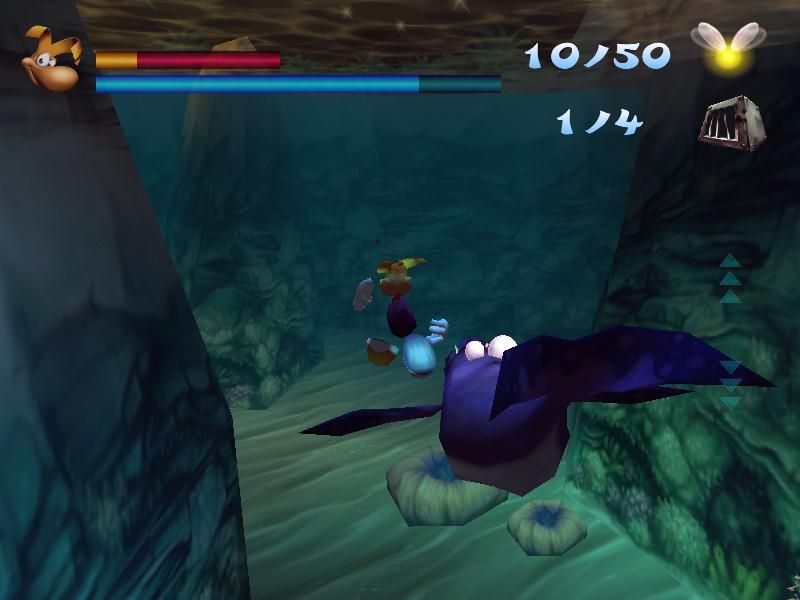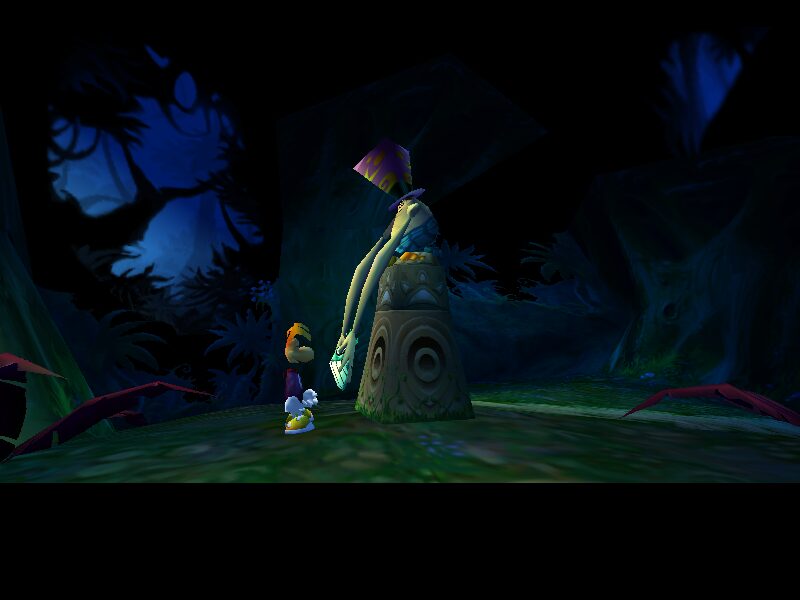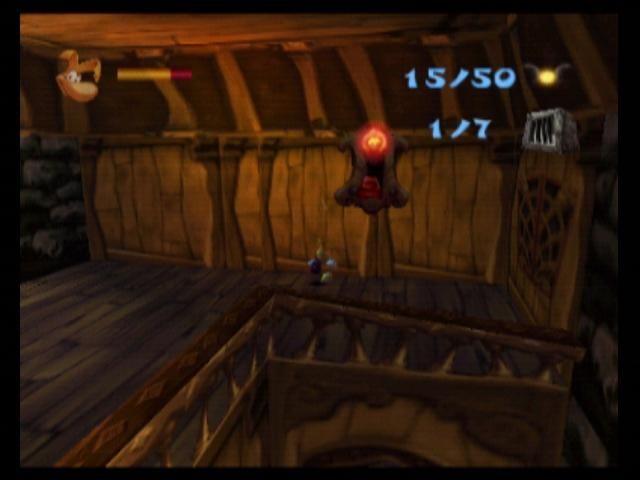Retro Replay Review
Gameplay
Rayman 2: The Great Escape shines most brightly in its core gameplay loop, which seamlessly blends free-roaming 3D platforming with inventive tool-based puzzles. From the moment Rayman regains his fist-shooting ability courtesy of the silver Lum, you’re encouraged to experiment with ranged combat, wall climbing, and gliding. The helicopter hair spin remains a delightful twist on double-jump mechanics, allowing you to gently float over hazards or reach distant platforms. Each ability feels distinct and well-paced, ensuring that new moves are introduced often enough to keep the experience fresh without overwhelming the player.
(HEY YOU!! We hope you enjoy! We try not to run ads. So basically, this is a very expensive hobby running this site. Please consider joining us for updates, forums, and more. Network w/ us to make some cash or friends while retro gaming, and you can win some free retro games for posting. Okay, carry on 👍)
The level design encourages exploration and replayability. Yellow Lums serve as both collectibles and gating mechanisms—the more you gather, the more worlds you unlock. Hidden paths, secret switches, and environmental puzzles reward curious players with life meter upgrades and access to buried masks. Special interactive objects, like powder kegs that can be carried or airborne, and rideable warheads that buck and swerve like mechanical stallions, add a playful chaos to traversal. The varied pacing of timed challenges, precision platforming, and optional mini-games creates a satisfying balance between challenge and fun.
Platform-specific enhancements further diversify the experience. The Dreamcast version adds the charming Globox Village mini-game hub, while the Nintendo 3DS build introduces a dynamic difficulty curve that eases up if too many Lums are missed. The PlayStation edition remixes level layouts, reduces the total Lums, and replaces the series’ trademark “twisted languages” with fully voiced dialogue, giving veteran players a fresh perspective on familiar content. On the PS2, you’ll find additional purchasable abilities, a Lumz Radar for tracking stray collectibles, and the convenience of mid-level saves—features that modern audiences will appreciate.
Combat encounters never overstay their welcome. Robo-pirates and minibosses test your reflexes without devolving into repetitive skirmishes. Boss fights strike a fine line between puzzle-oriented pattern recognition and reflex-based dodging, ensuring that each showdown feels unique. Thanks to responsive controls and tight collision detection, Rayman’s interactions with the world remain reliable across platforms, making for a gameplay experience that still holds up decades after its initial release.
Graphics
Though Rayman 2 first arrived in 1999, its vibrant art direction and imaginative level themes have aged gracefully. Each world boasts a distinct visual identity—be it the war-torn Pirate Stronghold, the misty caverns of The Mad Musketeer, or the lush, glowing foliage of the Dark Seas. Character models exhibit charming exaggeration, with expressive animations that sell every punch, hover, and tumble. Even in lower resolution ports, the hand-painted textures and bold color palettes pop off the screen, capturing the series’ whimsical spirit.
Technical performance varies by platform, but Ubisoft’s design choices minimize jarring dips or frame-rate issues. On the Nintendo 64 and original Windows editions, you’ll notice softer textures and occasional pop-in, yet the world’s geometry remains clear and readable. The Dreamcast build steps up the clarity, drawing out finer details in environments and character models. On more recent ports—iOS, 3DS, and select PS2 runs—texture filtering and higher resolutions give Rayman an extra sheen, while dynamic lighting and subtle particle effects enhance the atmosphere.
Environmental effects, such as water reflections, swirling fog, and torch flames, reinforce immersion without compromising performance. Weather transitions and day-night lighting shifts in certain levels add dramatic flair, highlighting the timeless quality of the underlying art assets. Even with limited polygons by today’s standards, the stylized look prevents Rayman 2 from feeling dated. In fact, the game’s cohesive artistic vision lends it a storybook charm that newer platformers sometimes lack.
Minor platform differences can influence visual detail. The PlayStation release swaps whisper-speak vocals for full speech, slightly altering lip sync but injecting fresh personality. The PS2’s rework of hub areas adds new decorative elements and shadow effects. Meanwhile, the 3DS’s stereoscopic 3D accentuates layer depth in foreground and background elements, though at the cost of lower texture fidelity. Whichever version you choose, Rayman 2’s graphics continue to set a benchmark for imaginative platform design.
Story
Rayman 2’s narrative kicks off under grim circumstances: Admiral Razorbeard and his army of robot pirates have enslaved the peaceful Teensies and drained the Lums—the very lifeblood of Rayman’s world. Captured and imprisoned aboard a sky-borne fortress, our limbless hero briefly succumbs to despair before an ally arrives. Globox, his bulky blue friend, smuggles in a single silver Lum gifted by Ly the Great Fairy, reigniting Rayman’s fighting spirit and setting the stage for a globe-trotting rescue.
The quest to recover the four Masks of Polokus forms the story’s spine, as each mask embodies an elemental facet of the world spirit. From navigating lava-filled forges to braving spectral catacombs, you feel the weight of the world’s fate with every new discovery. The narrative balances lighthearted banter—chiefly delivered in that signature gibberish banter—with genuinely suspenseful moments, such as infiltrating Razorbeard’s fortress or outsmarting the Mad Musketeer. Recurring characters like the loyal Teensies and enigmatic fairy Ly provide emotional grounding, ensuring you remain invested in the outcome.
Subplots emerge organically through environmental storytelling and cleverly disguised lore entries. Collecting golden Lums doesn’t just fuel progression mechanics; it underscores Rayman’s mission to rekindle hope across ravaged lands. Though not overly complex, the straightforward “hero saves world” premise gains depth from its memorable cast, imaginative locales, and the stakes of reawakening Polokus. Dialogue remains concise and witty, striking an ideal tone for players of all ages while subtly raising the tension as the final confrontation looms.
Across multiple ports, voice direction and script localization strategies differ, but the essence of the story remains intact. Whether you hear the witty “whisper speak” of the original versions or the fully voiced performances in later editions, the charm and humor filter through. Even decades later, Rayman 2’s narrative still feels refreshingly sincere, avoiding needless grittiness and embracing a timeless fairy-tale quality.
Overall Experience
Rayman 2: The Great Escape endures as a shining example of 3D platforming excellence. Its tight controls, varied level design, and whimsical art direction coalesce into an adventure that’s both approachable for newcomers and rewarding for seasoned veterans. Whether you’re chasing every hidden Lum, mastering aerial maneuvers, or simply soaking in the lore-rich environments, the game continually surprises and delights.
Platform selection hinges on your priorities: nostalgia and retro authenticity point toward the Nintendo 64 or original Windows release; enhanced visuals and content favor the Dreamcast or PS2 versions; modern convenience (and stereoscopic 3D) points to the 3DS port, while mobile play benefits from the iOS build. Each iteration embraces the same core strengths, with thoughtful bonuses—mini-games, dynamic difficulty, mid-level saves—that make replaying this classic an easy choice.
Even over twenty years after its debut, Rayman 2 strikes a near-perfect balance between challenge and accessibility. The blend of exploration, light combat, and environmental puzzles feels remarkably fresh compared to many contemporary platformers. Its upbeat soundtrack, charming sound design, and enduring sense of wonder ensure that few games have surpassed its creative ambition in the genre.
In short, Rayman 2: The Great Escape remains a must-own for platforming enthusiasts and families alike. Its combination of imaginative worlds, diverse mechanics, and heartfelt storytelling secures its place as one of the genre’s true standouts—an adventure that remains as inviting today as when it first launched.
 Retro Replay Retro Replay gaming reviews, news, emulation, geek stuff and more!
Retro Replay Retro Replay gaming reviews, news, emulation, geek stuff and more!









Reviews
There are no reviews yet.